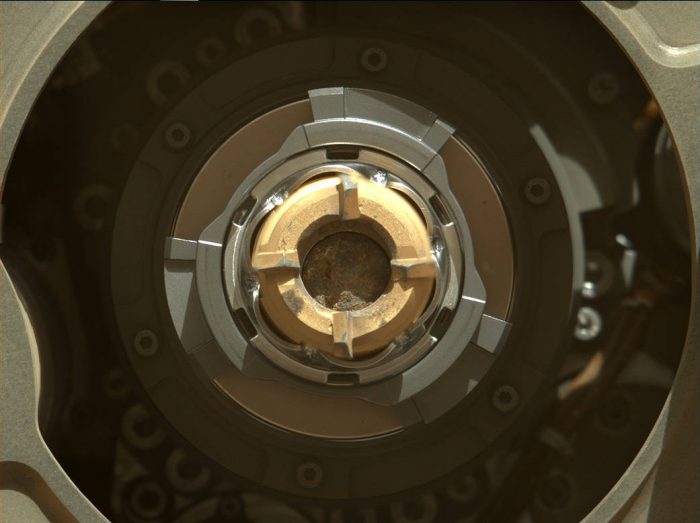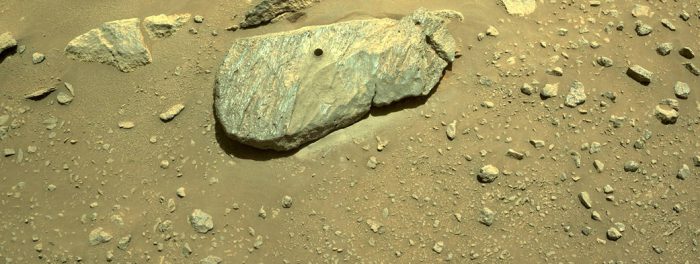Mars is currently home to several rovers ... and one of them is on rock detail!
The Perseverance rover is on a mission collect core samples of Martian rocks. And it has successfully grabbed its first one. You can see the neat, clean hole that it left behind on 'Rochette' above (that's the pet name that NASA gave to the rock itself—what a cute honour!).
Drilling a hole in a rock is all well and good, but why are they doing it? Because studying rocks is one of the ways that we learn about the history of a world.
Martian geology

The Rochette sample, collected and inside a storage container in Perseverance. (NASA/JPL-Caltech)
Here on Earth, geologists have been studying rocks for centuries to learn about everything from the movement of continents to ancient volcanic eruptions and the locations of lost oceans and rivers. It is also were fossils of the wide variety of prehistoric life are found. And that last point is what NASA scientists are hoping for with the Rochette sample.
Perseverance is currently found inside the Jezero crater, an area that researchers believe was a Martian seabed millions of years ago. This means that it would have been a prime location for life, if Mars ever had any. Could the rock sample contain remains of microbial life from eons past?
That would certainly be very exciting. And Perseverance is planning on collecting many more samples, too, to try and increase the chances of scientists finding what they're searching for. They'll just need to be patient. Because while Perseverance can collect these things, it can't send them back to Earth! Instead, we're going to have to wait until a ship that is designed to land and return to Earth is sent to Mars, which won't likely happen until the 2030s.
If only we didn't need to wait over a decade to check out some Martian rocks!
On display
Over the ages, Martian rocks have made their way to Earth as meteorites. (Getty Embed)
Well, maybe we don't. If you go to the Maine Mineral and Gem Museum in Bethel, Maine, you can actually visit a piece of Mars right now! Called Taoudenni 002, this is the largest Martian meteorite ever found on Earth. Recently, the 14.5-kg (32-lb.) rock was put on public display for the very first time.
Called a shergottite (which is a main type of Martian rock), you might well ask, How did this thing get here? Surprisingly, Martain meteorites aren't that uncommon. They were created ages ago when meteors struck the surface of Mars. These impacts sent shards of rock flying up into the atmospheret! Once in space, chunks of Mars would've spent millions of years wandering until they were caught in our orbit and fell to Earth.
So might this rock have any signs of microbial life preserved inside it? Well, no. Shergottite is an igneous rock formed by lava so no fossils here. That means we really will have to wait until we can the rover's Martian rock sample in ten years or so. At least we can go visit Taoudenni 002 in the meantime!
 An image of the drill hole made by Perseverance when it collected a rock sample on Mars. (NASA/JPL-Caltech)
An image of the drill hole made by Perseverance when it collected a rock sample on Mars. (NASA/JPL-Caltech)









